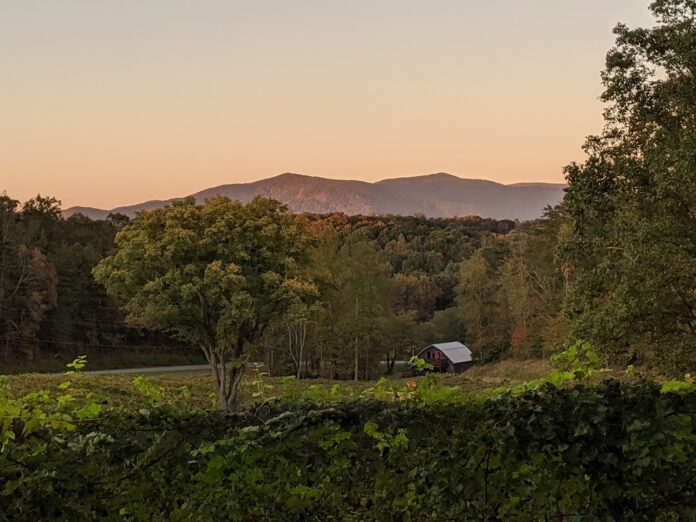
(Georgia Recorder) — Larry Lykins has learned to roll with the punches when it comes to threats to his 14-acre Ellijay vineyard.
His winery survived a virus spread via nursery plants several years after he bought the vineyard in 2007. More recently, he dealt with glassy-winged sharpshooters, a bug species that moves viruses from one plant to another.
So, when he heard last week that the spotted lanternfly – a fruit orchard pest with an insatiable appetite for grapes, peaches, plums and apples – had been sighted for the first time in Georgia, he remained calm.
“When I first started back in ’07 or ’08, we didn’t have to spray for insects very much,” said Lykins, owner of Cartecay Vineyards, a grower of several grape varieties, including Vidal Blanc, Catawba, Cabernet Sauvignon and Petit Verdot. “But now we do. It’s all part of warmer climates and globalization where bugs hitch rides on cargo ships.
“Being a farmer you just have to educate yourself and do the best you can with it,” he said.
The Georgia Department of Agriculture last week confirmed the first sighting of the spotted lanternfly on Oct. 22 in Fulton County, making the state the 18th in the nation that the pest now calls home and the most southern. The agency warned farmers, agriculture businesses and homeowners alike that the bug poses a serious risk to the state’s agricultural sector. It does not appear to pose a threat to humans.

The spotted lanternfly – which is more akin to an aphid or a stink bug – damages plants and trees by producing “a sticky, sugary waste fluid that encourages the growth of sooty mold,” the state said.
The remedy: kill it on sight, Georgia Agriculture Commissioner Tyler J. Harper said.
“We urge anyone who sees the spotted lanternfly in their area to document it, report it, and kill it,” he said in Thursday’s announcement. “Controlling the spread of the spotted lanternfly is our best strategy for safeguarding Georgia’s agriculture industry, and we are asking for the public’s help in this effort.”
The bug spreads by various methods, including laying eggs or egg masses on tires, chairs and vehicles, said Mike Evans, director of state agriculture department’s plant protection division.
The spotted lanternfly lays eggs from September to November, with nymphs born in the spring, state officials and experts said. Adults die at the first hard frost.
Paul McDaniel, forest health coordinator for the Georgia Forestry Commission, said elimination of the spotted lanternfly is critical to protect the state’s urban trees. Hardwoods in Georgia cities and large ex-urban communities already struggle for survival because of limited space for root growth and excessive sunlight from pavement, making it easier for the spotted lanternfly to cause damage.
“A lot of your urban trees already have stressors just being in that environment,” he said.
A major lure of the spotted lanternfly is the tree of heaven, an invasive deciduous tree that while not as prevalent in Georgia as in other states, still presents a host for the bug, said Sarah Lowder, a University of Georgia extension viticulture specialist and assistant professor of horticulture. Those with trees of heaven on their property should cut them down immediately to reduce the risk of a spotted lanternfly outbreak.
“It is one of their preferred food sources so you want to get rid of that so you don’t hopefully draw any of those in,” she said. “I guess it tastes the best.”
While it’s necessary to alert others to the threat the spotted lanternfly poses, Brett Blaauw said everyone should take a breath. There are still a lot of unknowns about how it will react in Georgia and what steps will be more effective to bring it under control, said Blaauw, a University of Georgia associate professor and extension specialist with a focus on grape growing
Blaauw on Thursday posted to a viticulture blog followed by Georgia vineyard owners that their crops are not in peril.
“We need to work as an industry to monitor, track, and manage this new pest,” he wrote in the blog. “While any new, invasive species is going to be scary, thankfully there has been a lot of work done in other states that we can adapt to be used in Georgia, so we are not starting from scratch.”
He said even if thousands of bugs are found swarming a single tree – which they sometimes have been known to do – the tree can often survive the ambush if it is well-established.
“For growers, seeing this bug that’s over an inch long, it can be quite intimidating,” said Blaauw, who also is a Clemson University associate professor.
It’s also unclear if the spotted lanternfly can take Georgia’s heat, especially the further south it travels, he said.
“It’s a new bug,” Blaauw said. “It’s probably going to expand in its population and its range in Georgia, but we need to not panic. At least not yet.”






